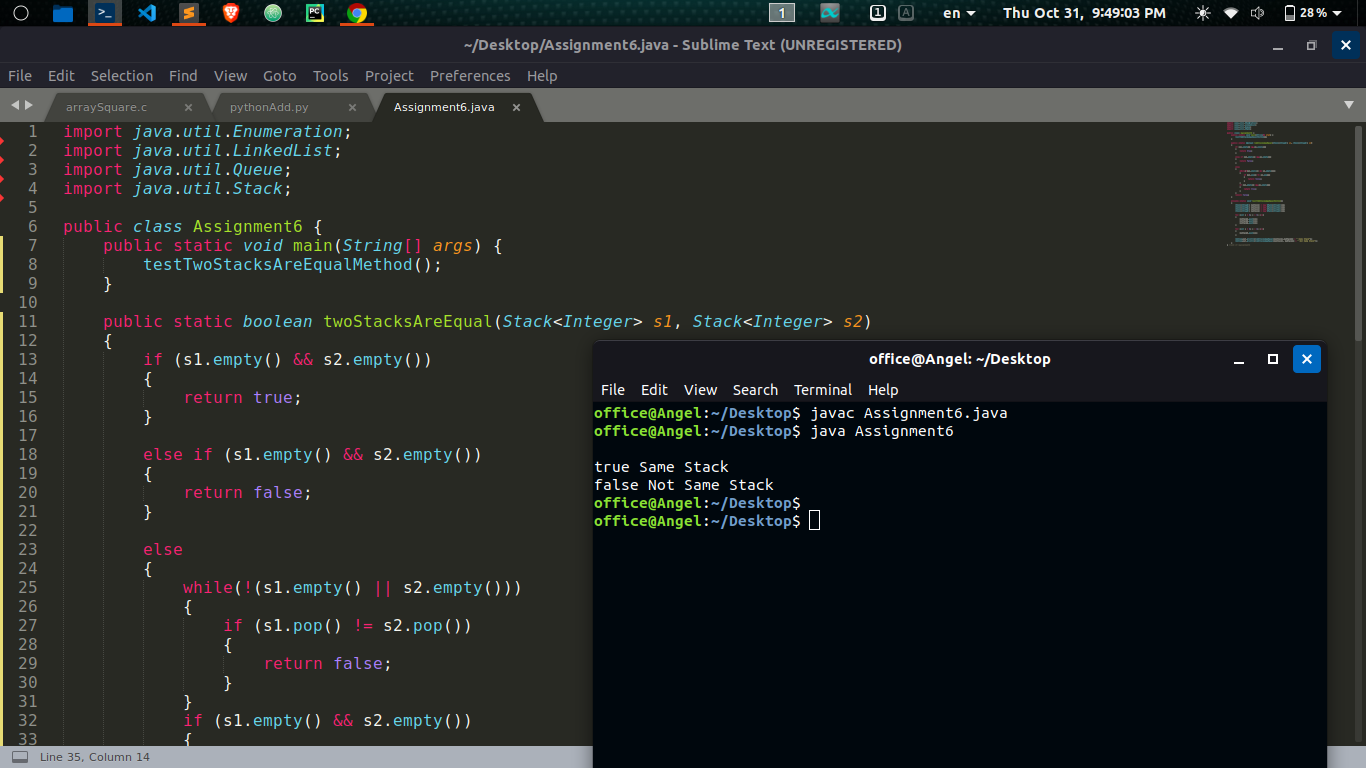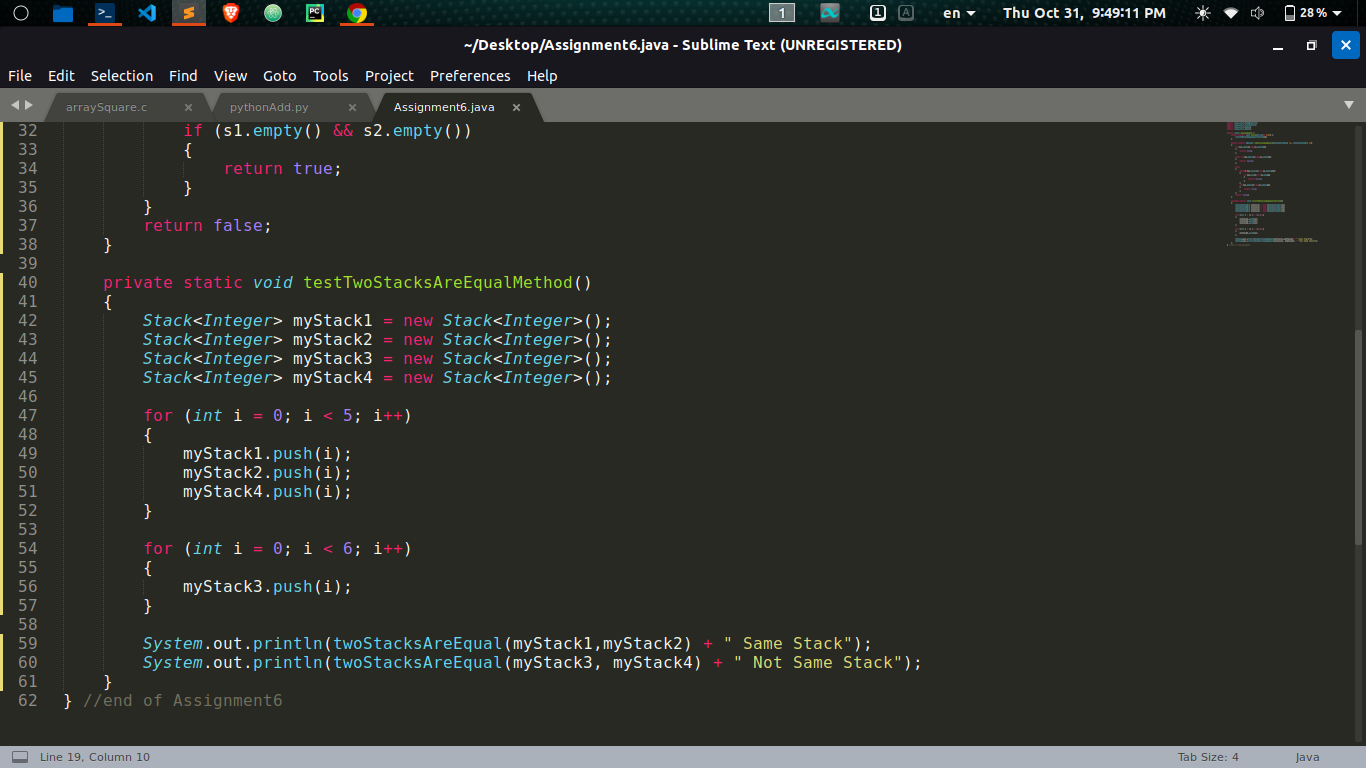Question
In: Computer Science
Write a method called "twoStacksAreEqual" that takes as parameters two stacks of integers and returns true...
Write a method called "twoStacksAreEqual" that takes as parameters two stacks of integers and returns true if the two stacks are equal and that returns false otherwise. To be considered equal, the two stacks would have to store the same sequence of integer values in the same order. Your method is to examine the two stacks but must return them to their original state before terminating. You may use one stack as auxiliary storage.
import java.util.Enumeration;
import java.util.LinkedList;
import java.util.Queue;
import java.util.Stack;
//Name,Class,Date..etc.. Header
public class Assignment6 {
public static void main(String[] args) {
//testSeeingThreeMethod();
//testTwoStacksAreEqualMethod();
//testIsMirrored();
}
public static void seeingThree(Stack<Integer> s) {
/*********Write Code Here************/
}
public static boolean twoStacksAreEqual(Stack<Integer> s1, Stack<Integer> s2)
{
/*********Write Code Here************/
}
public static boolean isMirrored(Queue<Integer> q) {
/*********Write Code Here************/
}
private static void testIsMirrored() {
Queue<Integer> myQueueP = new LinkedList<Integer>();;
for (int i = 0; i < 5; i++)
{
System.out.print(i);
myQueueP.add(i);
}
for (int i = 3; i >= 0 ; i--)
{
System.out.print(i);
myQueueP.add(i);
}
System.out.println();
System.out.println(isMirrored(myQueueP) + " isMirrord");
}
private static void testTwoStacksAreEqualMethod() {
Stack<Integer> myStack1 = new Stack<Integer>();
Stack<Integer> myStack2 = new Stack<Integer>();
Stack<Integer> myStack3 = new Stack<Integer>();
Stack<Integer> myStack4 = new Stack<Integer>();
for (int i = 0; i < 5; i++)
{
myStack1.push(i);
myStack2.push(i);
myStack4.push(i);
}
for (int i = 0; i < 6; i++)
{
myStack3.push(i);
}
System.out.println(twoStacksAreEqual(myStack1,myStack2) + " Same Stack
");
System.out.println(twoStacksAreEqual(myStack3, myStack4) + " Not Same
Stack");
}
private static void testSeeingThreeMethod() {
Stack<Integer> myStack = new Stack<Integer>();
for (int i = 0; i < 5; i++)
{
myStack.push(i);
}
System.out.println();
print(myStack);
seeingThree(myStack);
print(myStack);
}
private static void print(Stack<Integer> s) {
Enumeration<Integer> e = s.elements();
while ( e.hasMoreElements() )
System.out.print( e.nextElement() + " " );
System.out.println();
}
} //end of Assignment6
Solutions
Expert Solution
import java.util.Enumeration;
import java.util.LinkedList;
import java.util.Queue;
import java.util.Stack;
public class Assignment6 {
public static void main(String[] args) {
testTwoStacksAreEqualMethod();
}
public static boolean
twoStacksAreEqual(Stack<Integer> s1, Stack<Integer>
s2)
{
if (s1.empty() &&
s2.empty())
{
return
true;
}
else if (s1.empty() &&
s2.empty())
{
return
false;
}
else
{
while(!(s1.empty() || s2.empty()))
{
if (s1.pop() != s2.pop())
{
return false;
}
}
if (s1.empty()
&& s2.empty())
{
return true;
}
}
return false;
}
private static void
testTwoStacksAreEqualMethod()
{
Stack<Integer> myStack1 = new
Stack<Integer>();
Stack<Integer> myStack2 = new
Stack<Integer>();
Stack<Integer> myStack3 = new
Stack<Integer>();
Stack<Integer> myStack4 = new
Stack<Integer>();
for (int i = 0; i < 5;
i++)
{
myStack1.push(i);
myStack2.push(i);
myStack4.push(i);
}
for (int i = 0; i < 6;
i++)
{
myStack3.push(i);
}
System.out.println(twoStacksAreEqual(myStack1,myStack2) + " Same
Stack");
System.out.println(twoStacksAreEqual(myStack3, myStack4) + " Not
Same Stack");
}
} //end of Assignment6


Related Solutions
Write a recursive function named multiply that takes two positive integers as parameters and returns the...
In Python: Write a function called sum_odd that takes two parameters, then calculates and returns the...
Write a method, remove, that takes three parameters: an array of integers, the length of the array, and an integer called removeItem.
C++ write a function called divideBy that takes two integers as its input and returns the...
.. Write a method called findNums that takes a two-dimension array of integers as a parameter...
FOR JAVA Write a method called findNum that takes a two-dimension array of integers and an...
in java language Write a method called findNums that takes a two-dimension array of integers and...
write the “largerComponents” method that takes in two integer arrays and returns true or false if...
use java for : 1. Write a method called indexOfMax that takes an array of integers...
In.java In this program write a method called upDown that takes three integers as arguments and...
- Bonita Cole Inc. acquired the following assets in January of 2015. Equipment, estimated service life, 5...
- Accoring to the equation: AssO3 + 3C = 3CO +2As the reaction of 1gmol of AssO3...
- Create a program in Visual studio c++ Frank wants to take his wife, son, and daughter...
- Please show Each Formula and Each Step used to obtain the answer(s). How many 18 Watt...
- 1. Draw the money market with the value of money on the vertical axis and the...
- Even organizations as large and successful as State Farm Insurance have to plan for the future....
- Q. WHAT IS THEORY X AND THEORY Y? Q. IF YOU HAD YOUR OWN COMPANY, WOULD...
 venereology answered 2 months ago
venereology answered 2 months ago